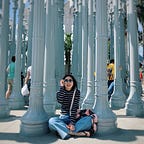Think from FIELD or OBJECT
In a discussion with Kristina, I found that my idea of starting a landscape project is always from the space inside the property line. It may be deeply influenced by the architecture education in the first three years of my undergraduate degree that the starting point of thinking habits is Object instead of Field. In this way, it is easy to ignore the influence and demand of the regional site, resulting in a sense of separation and detachment between the project design and the regional site. This is reflected in my Marin City design. In my later reflections, the lagoon park design seemed to be just a very gorgeous urban park design. It can be said that it is not against the harmony in New York or a big city in China. But without seeing the echo with other places, it is difficult to perceive that this park is located in Marin City with a unique culture. After that discussion, I reorganized Rodeo’s landscape armature and the environmental problems that exist in the entire city. Consider how to systematically improve the quality of economic life and the natural environment with an entry point. I develop an energy recycled corridor between the refinery and the community. Then based on this ecological core to create an urban ecological network with different-scale parks, gardens, LID streets, sewage with filtration system, electricity grid of algae fuel over the community, providing equal access for each resident to nature world with fewer greenhouse gases, cheaper energy resource.
After the presentation, I am still thinking about this issue. I remembered the photo of the armature that Kristina showed us when the lecture of the first assignment was. Those photos are so charming, although their exact location is unknown. But it allows us to read the overlapping relationship between different elements. Each pixel is a small unit of the dynamically balanced landscape. Together, they are a complex but stunningly beautiful mosaic art painting.
Because of this year’s internship, online class residence, summer vacation, etc., I have lived in five different cities for a period of time: Guangzhou, Shenzhen, Dali, Suzhou, and Shanghai. When you walk into the streets and alleys of these cities, you will experience the charm of each of these cities. But recently I opened google earth and tried to interpret the landscape armature of these cities from a birds-eye perspective.
Guangzhou is an ancient city but it expanded rapidly after the reform and opening up in 1980. At that time, the direction of urban expansion was not planned by the government but allocated to developers and factories to design and develop themselves in order to maximize the speed of construction. You can see Guangzhou like a messy collage and the curvilinear urban texture that is hard to see in Chinese cities. Before and after the Guangzhou Asian Games in 2010, the government rescued the urban villages in the city and transformed them into green spaces, which formed the urban context where the fragmented urban texture and the wedge-shaped green space merged.
Shenzhen is a newly built city after the reform and opening up in 1980. The entire city is rationally laid out based on modern urban planning theory, with sparse space and clear land use.
This is Suzhou. To the west is a two-thousand-year-old city outlined by a canal, and to the east is a new city planned for nearly ten years. The old and new ancient city is bounded by Jinji Lake and Dushu Lake. We can clearly see the trend of increasing block size and the influence of artificial water network.
The most eye-catching feature of Shanghai’s map is the change in architectural shadows. Common residential buildings in Shanghai are regular, with similar dimensions, and middle and high-rise buildings facing north-south. The most memorable memories of Shanghai — the skyscrapers reaching the sky are mainly distributed in the financial city on both sides of the Huangpu River, and they also serve as the background of the city skyline.
The landscape armature of Dali is from a regular transition sequence: Cangshan Mountain-New Town-Ancient City-Wheat Field and Village-Erhai Lake in the east. There is a highway division between each section. There are also landscape avenues running through the vertical sequence.
